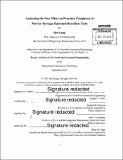Analyzing the size effect on fracture toughness of mortar through flattened Brazilian tests
Author(s)
Kang, Hao, Ph. D. Massachusetts Institute of Technology
DownloadFull printable version (18.96Mb)
Other Contributors
Massachusetts Institute of Technology. Department of Civil and Environmental Engineering.
Advisor
Herbert H. Einstein and John T. Germaine.
Terms of use
Metadata
Show full item recordAbstract
Much research has been conducted on fracture toughness and there has been a debate about whether the fracture toughness varies with specimen size. The purpose of this research is to investigate the size effect on the fracture toughness of mortar specimens. First, the methods for calculating elastic modulus, tensile strength, and fracture toughness in previous research are discussed. Some of the fracture toughness calculation methods proposed in them are not convincing, since the underlying assumptions have not been verified by experiments. Then, the experimental setup, including the material properties, specimen preparation, and the testing apparatus, are introduced. The mortar specimens were cast from Type III Portland Cement, finegrained silt, and water. Next, the numerical work on calculating the elastic modulus and the tensile strength is presented. The experimental results are shown. 107 experimental results at different specimen sizes (two-inch, three-inch and four inch) and different flatness angles (23°, 28°, and 39°) were used to investigate how the elastic modulus E, tensile strength [sigma]t, averaged compressive stress at local maximum loading [sigma]A, and averaged compressive stress at local minimum loading [sigma]B change with size and 2[alpha] (flatness angle). The change of fracture toughness, based on the local maximum loading, KICA, and the local minimum loading, KICB, with size and 2[alpha] was analyzed. KICA and KICB appear to be independent of the specimen size; while [sigma]t, [sigma]A, and [sigma]B decrease with increasing specimen sizes. As for the effect of 2[alpha], [sigma]t appears to be independent of 2[alpha], while [sigma]A and [sigma]B decrease with increasing 2[alpha]. In addition, High speed videos and high resolution images indicate that the primary crack initiated at the specimen center, and propagated along the vertical center line.
Description
Thesis: S.M., Massachusetts Institute of Technology, Department of Civil and Environmental Engineering, 2015. Cataloged from PDF version of thesis. Includes bibliographical references (pages 120-124).
Date issued
2015Department
Massachusetts Institute of Technology. Department of Civil and Environmental EngineeringPublisher
Massachusetts Institute of Technology
Keywords
Civil and Environmental Engineering.